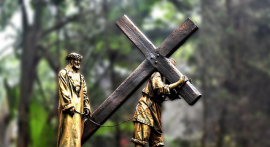
As the season of Lent approaches, many events and occasions are celebrated, including Ash Wednesday. Ash Wednesday is introduced as an opening or the indication that Lent is about to begin and is said to be celebrated 46 days before Easter Sunday.
Lent is a season that lasts for 40 days, excluding Sundays, and involves repentance, fasting, reflection, and celebration. This period is based on Christ's time in the wilderness, where he fasted for 40 days and was tempted by Satan.
During Lent, believers are encouraged to fast and focus on Christ's life, ministry, sacrifice, and resurrection. The season serves as a time for intentional reflection and spiritual growth.
What is Ash Wednesday, and Why is it Celebrated?
By late February or early March, it is noticeable that some people have crosses drawn on their foreheads using ash, and sometimes those who still need to learn what these are need clarification. Some people know but don't really know the meaning of it.
According to Christianity, Ash Wednesday, also known as the Day of Ashes, is the start of the Lent season and focuses on the repentance of sin and prayer, usually held through one's personal space and in a community. The priests celebrating this event usually focus their homily on penitential and reflective topics.
The service usually involves a responsive passage of Scripture, focusing on confession, read aloud by the leader and the congregation. This is followed by communal and silent moments of personal confession and prayer.
After the confession, the people in the church are invited to receive ashes on their foreheads. The ashes are usually applied in the shape of a cross by the priest or pastor, who dips their finger into the ashes and spreads them onto the forehead. The words "From dust you came and to dust you will return" are typically spoken during this ritual.
Why Must the People be Drawn Ashes on their Forehead in this Celebration?
During Mass on this day, a priest marks the forehead of the worshiper with ashes in the shape of a cross and says, "Remember that you are dust, and to dust, you shall return" or "Repent and believe in the Gospel." In the article in USA Today, it is believed that this ritual symbolizes the worshipper's acknowledgment of their sins and their desire for repentance and renewal.
The tradition of receiving ashes on Ash Wednesday dates back to 1091, and the ashes used in the ritual typically come from the palms from the previous year's Palm Sunday, which are burned and blessed before they are used. After receiving the ashes, the worshipper is not required to leave them on or take them off immediately but typically leaves them on for the rest of the day. The ashes are a visible reminder of one's mortality and the need for repentance and renewal during the Lenten season. Also, people must fast during the day, as explained in the following statement.
Also Read: Exploring the Different Types of Prayer: Petition, Intercession, Thanksgiving, and Worship
Why is there a need to Fast on Ash Wednesday?
Fasting is part of the celebration. Fasting is a practice that Christians do to honor Jesus' suffering and death on the cross and ready themselves to celebrate his resurrection. According to National Today, fasting is seen as a form of penance, asceticism, simplicity, and austerity. Jesus taught his disciples to fast, indicating that they should fast to honor him when he is no longer physically present with them. When fasting, believers must focus on God for nourishment and replenishment.
In the Latin Catholic Church, Ash Wednesday and Good Friday are mandatory fasting days, and members between 18 and 59 are allowed one full meal and two small meals throughout the day. Members over 14 must also abstain from meat. Eastern Catholic churches follow their specific directives. Abstaining from meat is a way to honor Jesus' sacrifice on the cross.
Can People Eat Meat?
It is believed that meat represents the flesh, and Jesus sacrificed his flesh during Good Friday. It has been a practice to abstain from meat on Fridays throughout the season of Lent, wherein fish is the only food allowed. Ages 14 and above are said to be required to follow this practice.
In particular, the Catholic Church traditionally requires its members to abstain from meat on Ash Wednesday and Fridays throughout Lent. The reason for this is twofold: first, it serves as a reminder of Jesus' sacrifice on the cross, and second, it is a form of solidarity with those who are less fortunate and cannot afford to eat meat regularly.
The season of Lent is about repentance, going away from sin, and believing in the teachings of the Gospel. Although some of these practices may seem uncomfortable, it is essential to note that a bit of sacrifice to honour Jesus won't hurt as much as he sacrificed his life for the world's sins.
Related Article: Bible Stories for Children to Learn and Grow: Nurturing Young Faith












